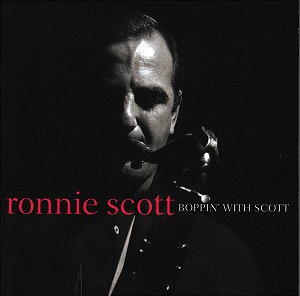CD 1
1. On the Sunny Side of the Street
2. Scrubber Time
3. Ad Lib Frolic
4. Lady Be Good
5. Boppin' At Esquire
6. Idabop
7. What Is This Thing Called Love
8. Buzzy (Pts. 1 & 2)
9. How High the Moon (Pts. 1 & 2)
10. Wee Dot
11. Coquette
12. 52nd Street Theme
13. Ow
14. Don't Blame Me
15. Stoned
16. Scrapple From the Apple
17. Donna Lee
CD 2
1. Gone With the Windmill
2. Barbados
3. Elevenses
4. Ool-Ya-Koo
5. Galaxy
6. Brand's Essence
7. Marshall's Plan
8. Too Marvellous For Words
9. Have You Met Miss Jones
10. September Song
11. Flamingo
12. Chasin' the Bird
13. Little Willie Leaps
14. El Sino
15. Crazy Rhythm
16. Close Your Eyes
17. I Didn't Know What Time It Was
18. The Nearness Of You
19. All Of Me
20. Not So Fast
21. Battle Royal
22. Fast
23. Twin Beds
24. Leap Year
25. The Champ
CD 3
1. Once In a While
2. Smoke Gets In Your Eyes
3. Scott's Expedition
4. Avalon
5. Love Me Or Leave Me
6. The Champ
7. All the Things You Are
8. Pantagrulian
9. Mullenium
10. Nemo
11. The Nearness Of You
12. Popo
13. The Champ
14. Nemo
15. All the Things You Are
CD 4
1. Troubled Air
2. Eureka
3. Seven Eleven
4. I May Be Wrong
5. On the Alamo
6. Day Dream
7. What's New
8. Ballot Box
9. Lover Come Back To Me
10. Compos Mentos
11. Stompin' At the Savoy
12. Body Beautiful
13. Sunshine On a Dull Day
14. Fools Rush In
15. Poor Butterfly
16. Perfidia
17. S'il Vous Plait
18. Jordu
19. Bang
20. With Every Breath I Take
21. A Night In Tunisia
22. The Big Fist
23. I'll Take Romance
24. Speak Low
Ronnie
Scott is probably best known as the founder
and long-term proprietor of the most famous
jazz club in London. Yet he was also a significant
tenor-saxist who played an important role
in the development of British jazz. So this
four-CD boxed set is not only a survey of
his early years but also a portrait of how
British jazz developed in the postwar years.
Ronnie
was typical of British jazzmen in being heavily
influenced what was happening in the USA,
which was then the undoubted centre of jazz.
Like many other British players, Ronnie joined
"Geraldo’s Navy" of young musicians
who got jobs aboard transatlantic liners so
that they could witness the New York jazz
scene for themselves. These visits cemented
Ronnie’s interest in bebop, and the tracks
in this collection illustrate his gradual
mastery of the form.
The
first tracks on CD1 are themselves derivative,
suggesting Ronnie’s debt to such tenorists
as Ben Webster and Coleman Hawkins (with pianist
Norman Stenfalt sounding very like Teddy Wilson).
But you can already hear a bebop influence
in Scrubber Time, while Ted Heath’s
big band sound on Ad Lib Frolic seems
to echo such Stan Kenton numbers as Intermission
Riff. By the time we reach Charlie Parker’s
composition Buzzy, the bebop influence
is well established. But this lusty performance
recorded at Birmingham Town Hall in 1946 includes
Carlo Krahmer’s bass drum thudding away with
four-in-a-bar, suggesting that the bebop basics
were not yet integrated. This track - and
How High the Moon from the same concert
- actually sounds more like a Jazz at the
Philharmonic blowing session than a performance
by Parker and Gillespie. If imitation is the
sincerest form of flattery, American musicians
could feel flattered, but it would still be
a while before the British jazzers found their
own voices. Subsequent tracks show this voice
developing very gradually, as Ronnie Scott
slowly builds his own personal style. The
1949 recordings made at London’s King George
Hall by the "Ronnie Scott Club XI Boptet"
continue the devotion to bebop but the sound
quality here is decidedly poor and fuzzy.
The
second CD starts with five cuts recorded in
1949 by Alan Dean’s Beboppers, with Alan Dean
scatting like mad and Laurie Morgan providing
over-busy drums in bop style. But there are
some confident solos from Ronnie Scott and
a young altoist called Johnny (or John) Dankworth.
This CD shows Scott gradually moving away
from bebop and sounding more like Stan Getz
on such 1951 tracks as Close Your Eyes
with the Ronnie Ball Trio.
And
so Ronnie continued to develop, although the
American influence continued to be strong.
A 1952 track like Popo betrays the
influence of Shorty Rogers and the American
west coast. But by the fourth CD, Ronnie Scott
is becoming his own man, despite British jazzers
too often being tempted to imitate the Americans
instead of creating their own music.
As
I said, this collection enables us to trace
changes in British jazz during the postwar
decade, and it is interesting to hear the
contributions from such notable British musicians
as Kenny Baker, Jimmy Deuchar, Derek Humble
and Victor Feldman. So this boxed set is a
fascinating historical document as well as
containing some fine music. It also embodies
a salutary lesson about the dangers of imitation
– a trap that British jazz finally escaped,
none too soon.
Tony
Augarde
